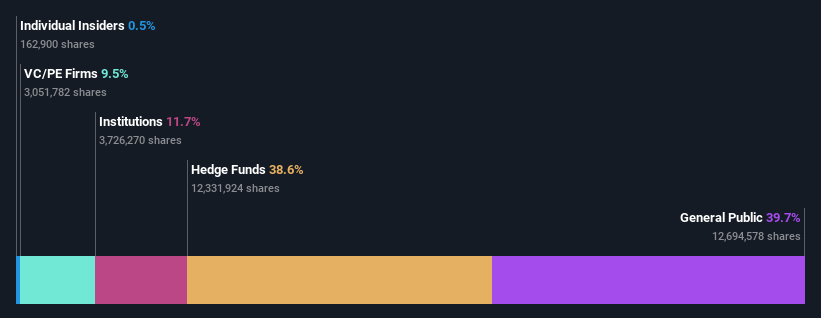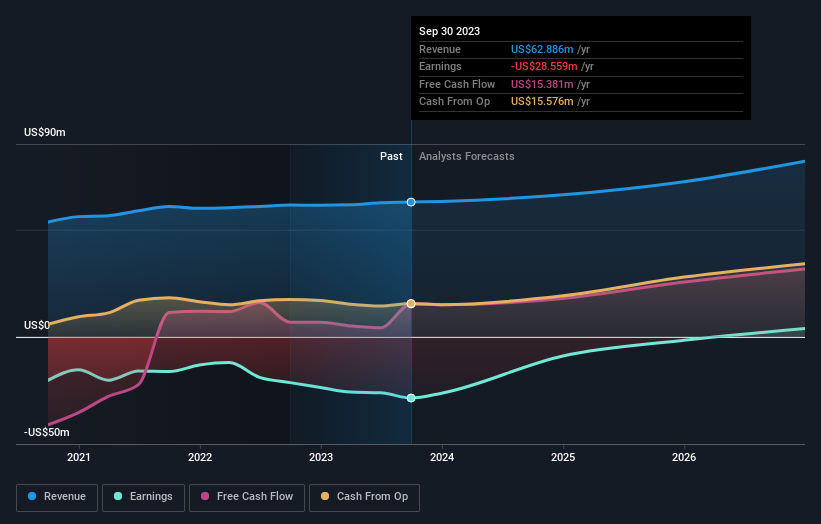HLS Therapeutics Inc. (TSE:HLS) stock most popular amongst retail investors who own 40%, while hedge funds hold 39%
Key Insights
Significant control over HLS Therapeutics by retail investors implies that the general public has more power to influence management and governance-related decisions
The top 4 shareholders own 58% of the company
To get a sense of who is truly in control of HLS Therapeutics Inc. (TSE:HLS), it is important to understand the ownership structure of the business. And the group that holds the biggest piece of the pie are retail investors with 40% ownership. Put another way, the group faces the maximum upside potential (or downside risk).
Hedge funds, on the other hand, account for 39% of the company's stockholders.
Let's delve deeper into each type of owner of HLS Therapeutics, beginning with the chart below.
View our latest analysis for HLS Therapeutics
What Does The Institutional Ownership Tell Us About HLS Therapeutics?
Many institutions measure their performance against an index that approximates the local market. So they usually pay more attention to companies that are included in major indices.
As you can see, institutional investors have a fair amount of stake in HLS Therapeutics. This suggests some credibility amongst professional investors. But we can't rely on that fact alone since institutions make bad investments sometimes, just like everyone does. It is not uncommon to see a big share price drop if two large institutional investors try to sell out of a stock at the same time. So it is worth checking the past earnings trajectory of HLS Therapeutics, (below). Of course, keep in mind that there are other factors to consider, too.
It would appear that 39% of HLS Therapeutics shares are controlled by hedge funds. That catches my attention because hedge funds sometimes try to influence management, or bring about changes that will create near term value for shareholders. Our data shows that Polar Asset Management Partners Inc. is the largest shareholder with 20% of shares outstanding. With 19% and 10% of the shares outstanding respectively, Stadium Capital Management, LLC and Mawer Investment Management Ltd. are the second and third largest shareholders.
Our research also brought to light the fact that roughly 58% of the company is controlled by the top 4 shareholders suggesting that these owners wield significant influence on the business.
Researching institutional ownership is a good way to gauge and filter a stock's expected performance. The same can be achieved by studying analyst sentiments. There are a reasonable number of analysts covering the stock, so it might be useful to find out their aggregate view on the future.
Insider Ownership Of HLS Therapeutics
The definition of an insider can differ slightly between different countries, but members of the board of directors always count. Company management run the business, but the CEO will answer to the board, even if he or she is a member of it.
Most consider insider ownership a positive because it can indicate the board is well aligned with other shareholders. However, on some occasions too much power is concentrated within this group.
Our most recent data indicates that insiders own less than 1% of HLS Therapeutics Inc.. It appears that the board holds about CA$697k worth of stock. This compares to a market capitalization of CA$137m. Many tend to prefer to see a board with bigger shareholdings. A good next step might be to take a look at this free summary of insider buying and selling.
General Public Ownership
The general public-- including retail investors -- own 40% stake in the company, and hence can't easily be ignored. While this group can't necessarily call the shots, it can certainly have a real influence on how the company is run.
Private Equity Ownership
Private equity firms hold a 9.5% stake in HLS Therapeutics. This suggests they can be influential in key policy decisions. Some might like this, because private equity are sometimes activists who hold management accountable. But other times, private equity is selling out, having taking the company public.
Next Steps:
I find it very interesting to look at who exactly owns a company. But to truly gain insight, we need to consider other information, too.
I like to dive deeper into how a company has performed in the past. You can find historic revenue and earnings in this detailed graph.
If you are like me, you may want to think about whether this company will grow or shrink. Luckily, you can check this free report showing analyst forecasts for its future.
NB: Figures in this article are calculated using data from the last twelve months, which refer to the 12-month period ending on the last date of the month the financial statement is dated. This may not be consistent with full year annual report figures.
Have feedback on this article? Concerned about the content? Get in touch with us directly. Alternatively, email editorial-team (at) simplywallst.com.
This article by Simply Wall St is general in nature. We provide commentary based on historical data and analyst forecasts only using an unbiased methodology and our articles are not intended to be financial advice. It does not constitute a recommendation to buy or sell any stock, and does not take account of your objectives, or your financial situation. We aim to bring you long-term focused analysis driven by fundamental data. Note that our analysis may not factor in the latest price-sensitive company announcements or qualitative material. Simply Wall St has no position in any stocks mentioned.


